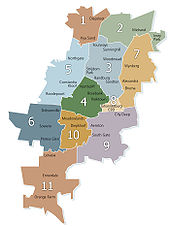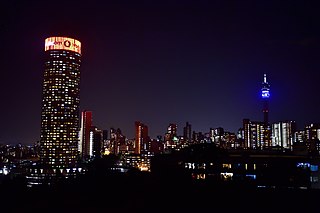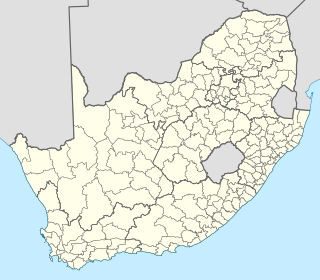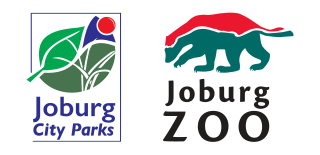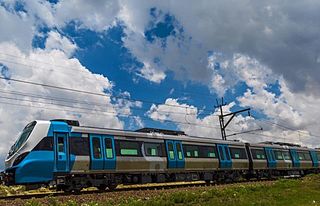| Place | Code | Population | Area (km2) | Most spoken languages |
|---|
| Alexandra | 798014 | 179,624 | 6.91 | Zulu 26%, Pedi 23%, Tsonga 11%, Xhosa 9%, Tswana 9%, Sotho 7%, Venda 4% |
| Chartwell | 798011 | 1,728 | 9.07 | English 50%, Afrikaans 10%, Zulu 9%, foreign languages 7%, Ndebele 7% |
| City of Johannesburg (non-urban) | 798002 | 9,933 | 289.84 | English 15%, Zulu 14%, Sotho 12%, Afrikaans 11%, Tswana 10%, Xhosa 8%, Pedi 8%, foreign languages 5%, Tsonga 4%, Venda 4% |
| Dainfern | 798012 | 6,601 | 4.08 | English 65%, foreign languages 15%, Afrikaans 4%, Zulu 4% |
| Diepsloot | 798003 | 138,329 | 12.00 | Pedi 22%, Zulu 19%, Tsonga 10%, Ndebele 10%, Venda 9%, Tswana 7%, Xhosa 5%, foreign languages 4%, Sotho 4% |
| Drie Ziek | 798035 | 35,622 | 7.53 | Zulu 42%, Sotho 28%, Xhosa 8%, Tsonga 7% |
| Ebony Park | 798007 | 22,309 | 1.63 | Pedi 29%, Zulu 23%, Tswana 7%, Tsonga 7%, Xhosa 6%, Sotho 6%, Ndebele 4%, English 4% |
| Ennerdale | 798033 | 71,815 | 21.33 | Afrikaans 19%, English 18%, Zulu 17%, Sotho 16%, Xhosa 8%, Tsonga 5%, Tswana 5% |
| Farmall | 798017 | 1,051 | 5.01 | English 47%, Afrikaans 12%, foreign languages 9%, Zulu 7%, Pedi 5%, Tswana 4%, Ndebele 4% |
| Itsoseng | 798021 | 5,243 | 0.58 | Pedi 22%, Venda 15%, Tswana 13%, Zulu 11%, Ndebele 7%, Sotho 7%, Tsonga 7%, English 4%, foreign languages 4%, Xhosa 4% |
| Ivory Park | 798006 | 184,383 | 9.21 | Pedi 23%, Tsonga 22%, Zulu 21%, Xhosa 7%, foreign languages 5%, Ndebele 5%, Sotho 4% |
| Johannesburg | 798015 | 957,441 | 334.81 | English 31%, Zulu 19%, Afrikaans 12%, foreign languages 7%, Xhosa 5%, Ndebele 4%, Sotho 4%, Pedi 4%, Tswana 4%, Tsonga 3%, Venda 1% |
| Kaalfontein | 798005 | 46,147 | 4.96 | Pedi 30%, Zulu 21%, Tsonga 10%, Xhosa 8%, foreign languages 5%, Sotho 5%, Ndebele 5%, Tswana 4% |
| Kagiso | 798024 | 5,182 | 0.57 | Tswana 33%, Zulu 17%, Xhosa 11%, Sotho 9%, Tsonga 8%, Venda 5%, Pedi 4% |
| Kanana Park | 798039 | 21,005 | 6.82 | Zulu 35%, Xhosa 22%, Sotho 20%, Tsonga 5% |
| Lakeside | 798037 | 23,503 | 3.78 | Sotho 48%, Zulu 30%, Xhosa 8% |
| Lanseria | 798019 | 4,788 | 1.83 | Pedi 19%, Tswana 15%, Zulu 15%, Tsonga 10%, Venda 8%, English 7%, Sotho 6%, Xhosa 6%, Ndebele 5% |
| Lawley | 798038 | 33,136 | 6.09 | Zulu 28%, Sotho 20%, Tsonga 13%, Xhosa 8%, English 5%, Tswana 5%, Pedi 4%, Venda 4%, Afrikaans 4% |
| Lehae | 798029 | 13,380 | 3.50 | Zulu 42%, Sotho 13%, Tsonga 12%, Xhosa 10%, Tswana 5% |
| Lenasia | 798028 | 89,714 | 20.28 | English 55%, Zulu 8%, Tswana 8%, Sotho 6%, Xhosa 4%, foreign languages 4%, Afrikaans 4% |
| Lenasia South | 798032 | 37,110 | 13.98 | English 53%, Zulu 12%, Sotho 8%, Xhosa 5%, Tswana 5% |
| Lucky 7 | 798020 | 0 | 0.11 | n. a. |
| Malatjie | 798001 | 2,321 | 0.18 | Pedi 23%, Tswana 13%, Zulu 12%, Venda 12%, Ndebele 9%, Tsonga 7%, Sotho 6%, foreign languages 5%, Xhosa 4% |
| Mayibuye | 798009 | 22,178 | 1.16 | Pedi 24%, Zulu 18%, Xhosa 15%, Tsonga 9%, Ndebele 9%, foreign languages 7%, Sotho 4% |
| Midrand | 798004 | 87,387 | 152.87 | English 50%, Zulu 10%, Afrikaans 6%, foreign languages 5%, Xhosa 5%, Tswana 5%, Pedi 4%, Sotho 4% |
| Millgate Farm | 798018 | 172 | 0.88 | n. a. |
| Orange Farm | 798034 | 76,767 | 12.16 | Zulu 44%, Sotho 29%, Xhosa 9%, Tsonga 4% |
| Poortjie | 798040 | 11,153 | 2.43 | Sotho 38%, Zulu 19%, Xhosa 18%, Tsonga 9%, Tswana 5% |
| Rabie Ridge | 798008 | 41,204 | 3.33 | Pedi 32%, Zulu 16%, Tsonga 9%, Afrikaans 8%, Xhosa 8%, Sotho 5%, Tswana 4%, Ndebele 4% |
| Randburg | 798016 | 337,053 | 167.98 | English 52%, Afrikaans 17%, Zulu 6%, foreign languages 5%, Tswana 4% |
| Randfontein | 798027 | 0 | 9.19 | n. a. |
| Rietfontein | 798023 | 196 | 2.17 | n. a. |
| Roodepoort | 798022 | 326,416 | 161.50 | English 29%, Afrikaans 23%, Zulu 9%, Tswana 8%, Pedi 4%, Xhosa 4%, Sotho 4%, foreign languages 3%, Venda 3% |
| Sandton | 798013 | 222,415 | 143.54 | English 63%, Afrikaans 7%, Zulu 6%, foreign languages 6% |
| Soweto | 798026 | 1,271,628 | 200.03 | Zulu 37%, Sotho 15%, Tswana 12%, Tsonga 8%, Pedi 5%, Venda 4%, English 2%, Ndebele 1%, Afrikaans 1%, foreign languages 1% |
| Stretford | 798036 | 61,141 | 7.38 | Zulu 39%, Sotho 34%, Xhosa 9%, Tsonga 4% |
| Tshepisong | 798025 | 53,260 | 6.56 | Zulu 26%, Tswana 22%, Xhosa 12%, Tsonga 12%, Sotho 9%, Pedi 5%, Venda 5% |
| Vlakfontein | 798031 | 27,291 | 4.63 | Zulu 38%, Sotho 17%, Tsonga 10%, Xhosa 9%, Tswana 6%, Pedi 4% |
| Zakariyya Park | 798030 | 6,200 | 1.96 | English 34%, Zulu 20%, Sotho 9%, Tswana 6%, Xhosa 6%, Tsonga 5%, foreign languages 4% |
| Zevenfontein | 798010 | 0 | 3.11 | n. a. |



